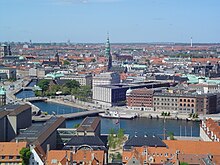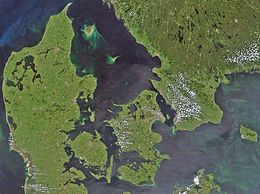|
Geography of Denmark
Denmark is a Nordic country located in Northern Europe. It consists of the Jutland Peninsula and several islands in the Baltic Sea, referred[citation needed] to as the Danish Archipelago. Denmark is located southwest of Sweden and due south of Norway and is bordered by the German state (and former possession) Schleswig-Holstein to the south, with a 68-kilometre (42-mile) long land border. Denmark borders both the Baltic and North seas along its 8,750 km (5,440 mi) tidal shoreline. Denmark's general coastline is much shorter, at 1,701 km (1,057 mi), as it would not include most of the 1,419 offshore islands (each defined as exceeding 100 square metres (1,100 sq ft) in area) and the 180-kilometre long (110 mi) Limfjorden, which separates Denmark's second largest island, North Jutlandic Island, 4,686 km2 (1,809 sq mi) in size, from the rest of Jutland. No location in Denmark is further from the coast than 52 km (32 mi). The land area of Denmark is estimated to be 43,094 km2 (16,639 sq mi). However, it cannot be stated exactly since the ocean constantly erodes and adds material to the coastline, and there are human land reclamation projects. On the southwest coast of Jutland, the tide is between 1 and 2 m (3.28 and 6.56 ft), and the tideline moves outward and inward on a 10 km (6.2 mi) stretch.[1] A recent global remote sensing analysis suggested that there were 607 km2 (234 sq mi) of tidal flats in Denmark, making it the 42nd ranked country in terms of tidal flat extent.[2] Denmark has an Exclusive Economic Zone of 105,989 km2 (40,923 sq mi). When including the Faroe Islands and Greenland, the EEZ is the 15th largest in the world with 2,220,093 km2 (857,183 sq mi). A circle enclosing the same total area as Denmark would have a diameter of 234 km (146 miles). Denmark has 443 named islands (1,419 islands above 100 m2 (1,100 sq ft)),[3] of which 72 are inhabited (as of 1 January 2007[update], Statistics Denmark). The largest islands are Zealand (Sjælland) and Funen (Fyn). The island of Bornholm is located east of the rest of the country, in the Baltic Sea. Many of the larger islands are connected by bridges; the Øresund Bridge connects Zealand with Sweden; the Great Belt Bridge connects Funen with Zealand; and the Little Belt Bridge connects Jutland with Funen. Ferries or small aircraft connect to the smaller islands. Main cities are the capital Copenhagen on Zealand; Århus, Aalborg and Esbjerg in Jutland; and Odense on Funen. Denmark experiences a temperate climate, with mild, windy winters and cool summers. The local terrain is generally flat with a few gently rolling plains. The territory of Denmark includes the island of Bornholm in the Baltic Sea and the rest of metropolitan Denmark, but excludes the Faroe Islands and Greenland. Its position gives Denmark complete control of the Danish straits (Skagerrak and Kattegat) linking the Baltic and North Seas. The country's natural resources include petroleum, natural gas, fish, salt, limestone, chalk, stone, gravel, and sand. Environment   Climate
Land use
Irrigated land: 4,354 km2 (1,681 sq mi) (2007) Total renewable water resources: 6 km3 (1.4 cu mi) (2011)  Freshwater withdrawal (domestic/industrial/agricultural):
Land reclamationIn 2019, the government proposed building 9 new artificial islands, named project Holmene, which would create 3 km2 (1.2 sq mi) of reclaimed land, to be built from 2022 to 2040.[4] In June 2021, lawmakers approved the construction of a 3 km2 (1.2 sq mi) island, named Lynetteholm, in the Copenhagen Harbor.[5] A spokesperson for the Climate Movement in Denmark (Klimabevægelsen i Danmark) said the organization would sue the government over environmental concerns.[6][needs update] AgricultureDenmark has plenty of rain, flat landscape, and moderate climate. With 55.99% of its land considered as arable, Denmark has model characteristics for agriculture. 61% of the country's total area is cultivated [7] Farms in Denmark are remarkably large, averaging 70.0 hectares (172.9 acres) per farm. Additionally, homesteads exceeding 100 hectares (247 acres) make up more than 20% in Denmark. Many of these large farms harvest fruits and vegetables, the leading exports from Denmark are meat, fur, and dairy products.[7] The animal's diets in Denmark consist of mainly cereals since they are the dominant field crop. 75% of all cereal produced in Denmark is feed to the four most produced animals which are pigs, cattle, chicken and mink.[7] Denmark overproduces about 66% of food production compared to their own population size (5.7 million) being that they are able to feed 15 million people. This is a byproduct of being highly productive within the Danish agricultural production.[7] In 1961, Denmark's Agricultural land represented 74.5% of land area. Fifty-six years later to 2015, Denmark has decreased its amount of Agricultural land down to 62.1%[8] then to 61% one year later in reference to "Facts and Figures - Danish Agriculture and Food"[7] The decrease in agricultural land comes as farmers are being well educated and the intensive amount of research and development is being implemented. It begins with advancements in agro-technology. The results have improved fertilization and nutrient use on arable land. Digestibility and nutrient uptake are developing from the improvements of new methods that are being implemented. Examples of these new methods are the addition of enzymes and microbial cultures.[7] Natural hazards
Current issues
International agreements
Transnational issuesMaritime claims
Other issues
PopulationUrban population
See also
NotesFootnotes
ReferencesThe World Book Encyclopedia (2003 ed.). World Book. 1974. ISBN 0716601036. External links
|
||||||||||||||||||||||||||||||||||||||||||||||||||||||||||||||||||||||||||||||||||||||||||||||||||||||||||||||||||||||||||||||||||||||||||||||||||||||||||||||||||||||||||||||||||||||||||||||||||||||||||||||||||||||||||||||||||


